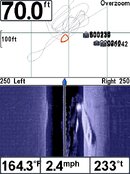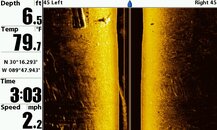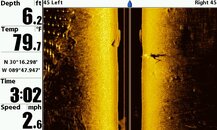I found something. I should have looked before asking the question. They make a small size that can be attached to a diver.
Home | SonarBell®SonarBell® Might be interesting to see how well it works. Like putting one on each diver you put in the water and seeing how well you could track them during the dive.
Well, to track someone during a dive, you have to be looking for them. That isn't as easy as it sounds.
For instance, on the Spree, we have a bottom sounder. The bottom sounder has a transducer that looks straight down. Beam angle is 0.5 degrees from the transducer, so I get a very accurate return of what is directly under the boat, but it wouldn't let me see a body unless I were moving, and it were directly under me in 50-100 feet of water. Depth is based on the frequency of the sonar pings, and the number of pings per second.
Now, if you want to see a shape or a body, wreck, ledge, etc. You either need a lot more transducers or you need something called "Backscatter". A multi-beam sonar utilizes multiple beams to create a 3D image of the bottom, where a bottom sounder has one beam, a multibeam may have 50 on a less expensive unit ($50k plus the cost of software) and as many as 1,000 beams on a very expensive unit ($2.5M plus the cost of software. Same software, BTW). Multibeam sonars are pretty much out of the reach of most guys like myself.
Sidescanning sonars work differently, and much of it is PFM and magic smoke, but as I understand it, there 2 lobes of receivers, one on each side of the sidescan (hence the name, get it?) that receive the sonar signal sent out from the nose of the unit. Since different materials reflect back at different speeds, you get a phenomena called backscatter that allows for a 3D image to be formed. Since the receivers are on the sides of the unit, it does not look straight down, as you wouldn't get an effective backscatter. That's why there is a line in the middle of a sidescan image. Sidescan sonars run from $10K for a new JW Fishers to $100K for the latest Edgetech.
The proper tool to track a diver is with some sort of electric pinger and 3D imaging receiver. There is a thread here somewhere about just such a machine to be debuted at DEMA. I did not see it there, although I was interested. I think the cost was around $2500 for a receiver and a few pingers....






